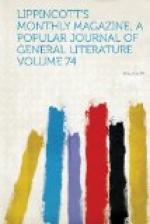Leaving the typographical treasures of the library, we ascend the broad marble stairway to the floor above, for a brief glance at the paintings and statuary. In the hall devoted to sculpture are many noble and beautiful works of art in marble, the most noticeable perhaps being Powers’s “Il Penseroso,” the bust of Washington and the “Babes in the Wood” by Crawford, and the statue of Lincoln by Ball. In the picture-gallery on the east are a hundred and fifty subjects. On the south wall hangs a canvas which is at once recognized as the masterpiece. It is Munkacsy’s “Blind Milton dictating ‘Paradise Lost’ to his Daughters.” This painting is fitly supported on one side by a portrait of Milton owned for many years by Charles Lamb, and on the other by a copy of Lely’s fine portrait of Cromwell.
The Mercantile is the popular library of the city; in no sense a public library, however, for the student or stranger must advance a pretty liberal entrance-fee before he can avail himself of its benefits. This institution is a pleasing example of what can be done by many hands, even though there be little in them: it has reached its present proportions without endowment or State aid, chiefly through the steady, continuous efforts of the merchants’ clerks of the city. They have always managed it, one generation succeeding another, and they have in it to-day the largest circulating library in America. Mr. William Wood, a benevolent gentleman who devoted many of his later years to improving the condition of clerks, apprentices, and sailors, is regarded as the founder. Mr. Wood was a native of Boston, and in business there during early life, but later removed to London. After distributing much dole to the poor of that city, he founded a library for clerks in Liverpool, and subsequently one in Boston, the latter being the first of its kind in this country. The various mercantile libraries at Albany, Philadelphia, New Orleans, and other places are said to have been founded on the plan of this. In 1820 Mr. Wood began interesting the merchants’ clerks of New York in the project of a library for themselves.




